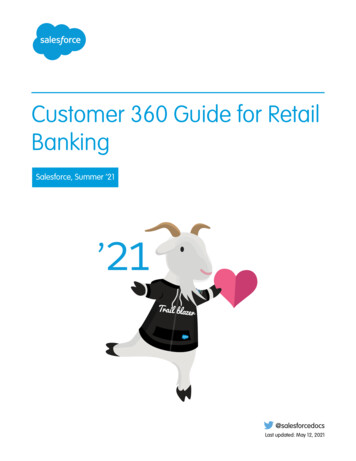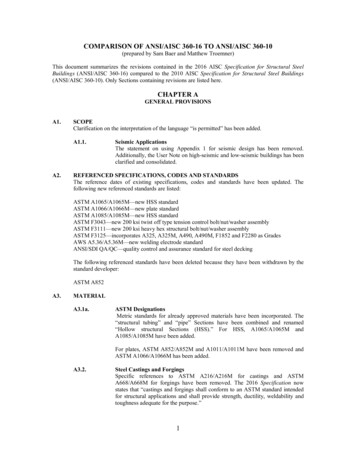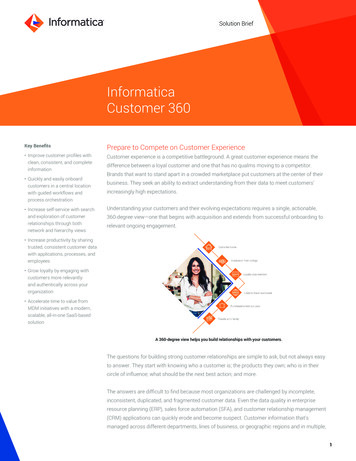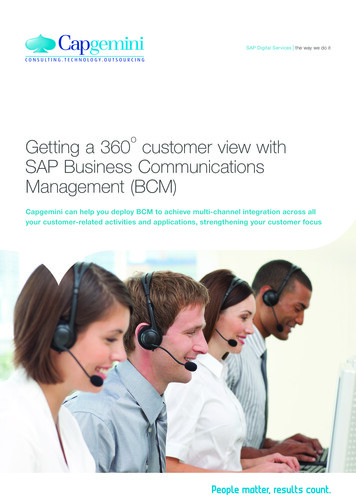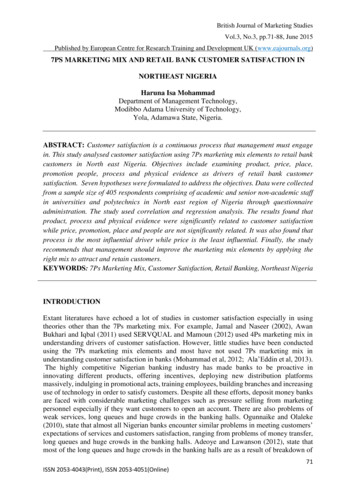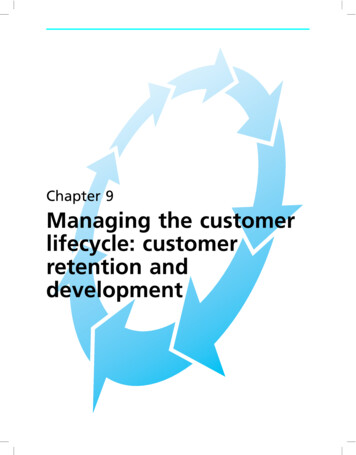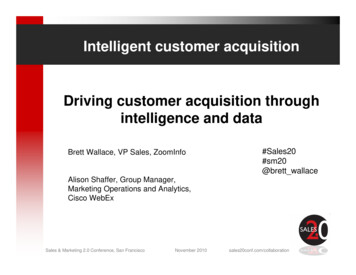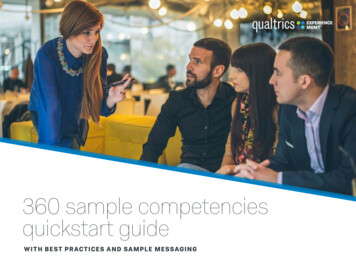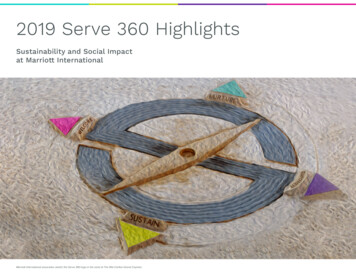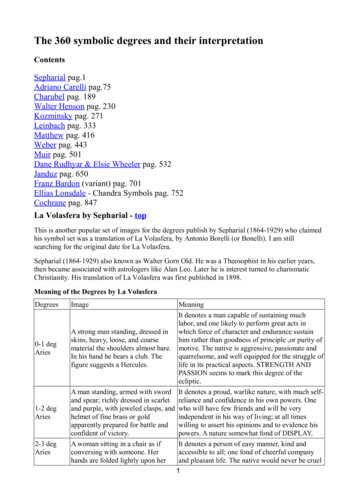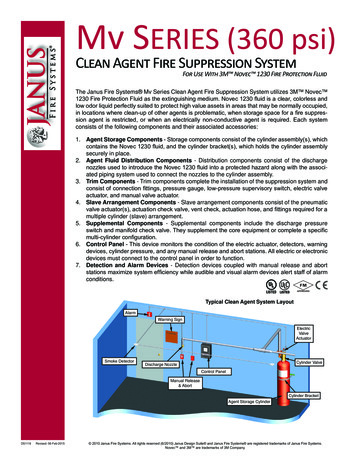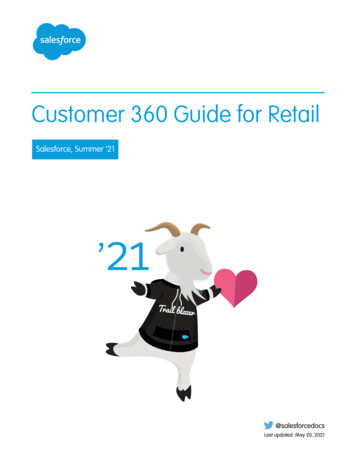
Transcription
Customer 360 Guide for RetailSalesforce, Summer ’21@salesforcedocsLast updated: May 20, 2021
Copyright 2000–2021 salesforce.com, inc. All rights reserved. Salesforce is a registered trademark of salesforce.com, inc.,as are other names and marks. Other marks appearing herein may be trademarks of their respective owners.
CONTENTSCustomer 360 Guide for Retail . . . . . . . . . . . . . . . . . . . . . . . . . . . . . . . . . . . . . . . . . . . 1Industry Blueprint for Retail . . . . . . . . . . . . . . . . . . . . . . . . . . . . . . . . . . . . . . . . . . . . . . . . 1Reference Architecture for Retail . . . . . . . . . . . . . . . . . . . . . . . . . . . . . . . . . . . . . . . . . . . . 3Business Scenarios for Retail . . . . . . . . . . . . . . . . . . . . . . . . . . . . . . . . . . . . . . . . . . . . . . 6Solution Architecture for Retail . . . . . . . . . . . . . . . . . . . . . . . . . . . . . . . . . . . . . . . . . . . . 55Solution Kits for Retail and B2C . . . . . . . . . . . . . . . . . . . . . . . . . . . . . . . . . . . . . . . . . . . . 60
CUSTOMER 360 GUIDE FOR RETAILExplore the power of multi-cloud solutions to create customer experiences that connect with customers, grow your business, and provideresilience to market changes.The assets in this Customer 360 Guide help you build a vision for the future of your retail business and implement the changes neededto fully realize your digital transformation. Learn with TrailheadArchitectural diagrams and business scenarios show you how Salesforce products combine with industry best practices to expand yourbusiness capabilities. Solution Kits show you how to implement Salesforce-recommended cross-cloud solutions to common retail usecases.Industry Blueprint for RetailGet key product and industry information you can use to uncover opportunities and build retail solutions.Reference Architecture for RetailMap specific Salesforce products to the functional and platform capabilities needed for retail business to thrive.Business Scenarios for RetailBusiness scenarios help you bridge the gap between your organization's business capabilities and the solutions needed to achieveyour goals. For each scenario, discover a variety of Salesforce solutions that reduce your time to value and allow you to define aroadmap to build out your organization’s functionality.Solution Architecture for RetailIdentify specific tools and resources that you need to deliver cross-cloud retail solutions for your business.Solution Kits for Retail and B2CEnhance your retail business by implementing one or more solution kits. Get product recommendations, workflow details, andinstructions to help you implement the solution from start to finish.SEE ALSO:Customer 360 Guide for Retail Learning MapCustomer 360 Guide for Retail: Quick LookCustomer 360 Guides: Quick LookIndustry Blueprint for RetailGet key product and industry information you can use to uncover opportunities and build retail solutions.The industry blueprint diagrams the end-to-end retail process, from customer acquisition to analytics and optimization. Learn withTrailheadUse the industry blueprint to lay the groundwork for your digital transformation. Map common B2C retail business capabilities to the stages of the customer lifecycle and front-office processes. Determine which capabilities are most important to your organization, and create alignment with cross-functional stakeholders. Understand the high-level platform capabilities needed to power your organization’s business needs.1
Customer 360 Guide for RetailIndustry Blueprint for RetailContact your Salesforce account team or a Salesforce partner for help with assessing the business and platform capabilities most suitedfor your organization.The retail industry blueprint shows a product-agnostic overview of key business capabilities common to most B2C retailers.The business processes of a typical lifecycle of a customer relationship can be organized into seven phases.1. Awareness and Acquisition2. Personalization and Experience3. Transact and Fulfill4. Customer Service5. Store6. Merchandising and Supply Chain7. Corporate ManagementCapabilities within the seven phases can be grouped into five areas: Drive Agility with Data and Analytics, Transform Business Relationships,Acquire and Engage Loyal Customers, Meet Shoppers Where They Are, and Reimagine the Role of the Store and Associate. These arethe business needs that must be satisfied at each stage of the lifecycle for the retailer to achieve business success.Tip: To understand which business capabilities, solutions, and Salesforce products can help your organization achieve the businessneeds identified on the blueprint, dive deeper into B2C business scenarios.Platform enablers, APIs, and data sources are common to all lifecycle stages and business processes. Use platform enablers, APIs, anddata sources as a baseline of functionality to support tailored solutions.2
Customer 360 Guide for RetailReference Architecture for RetailNote: To understand how industry and business requirements link to the underlying technologies that support them, review theReference Architecture for Retail on page 3. Use the B2C industry blueprint as a building block for creating a reference architecturefor planning customer experience enhancements.SEE ALSO:Industry Blueprints for PartnersSalesforce Architectural Diagrams: Quick LookReference Architecture for RetailSolution Architecture for RetailReference Architecture for RetailMap specific Salesforce products to the functional and platform capabilities needed for retail business to thrive.To build end-to-end solutions that meet the needs of customers through the entire purchase process, businesses must deliver solutionsacross teams and technology stacks. The reference architecture helps communicate the vision and strategy of a solution to businessexecutives and stakeholders. Learn with TrailheadBusiness success can be conceptualized as success in each of three categories of capabilities: Foundational, Platform, and Functional.Our reference architecture presents Platform and Functional capabilities. Each layer contains a representative subset of systems orcapabilities that are most relevant in the B2C Retail space. It does not list all possible systems or capabilities.3
Customer 360 Guide for RetailReference Architecture for RetailPlatform CapabilitiesThese components form the underlying technology base for achieving your goals. Each layer in the platform builds on top of the next.B2C systems typically rely on these elements.Data SourcesData sources are systems that create, collect, and manage various types of data. These systems can act as systems of record. They’reoften purpose-built to handle particular functionality and data requirements, but some provide for general system needs.IntegrationsIntegrations include tools and routes that connect systems of record with each other or with higher-level experiences. These arevaried tools, such as APIs that connect separate systems, single sign-on services to manage customer identity across differentinterfaces, and customer data platforms to segment customers.IntelligenceSmart automation like machine learning and AI helps you optimize your use of customer data. The intelligence layer serves functionslike delivering actionable customer insights, personalized product recommendations, and improving real-time customer interactionsto enhance your customer relationships and drive sales.AnalyticsAnalytics helps you better understand your data and make smart business decisions. Descriptive analytics summarize existing data to help you better understand current state or past activities. These analytics typicallyanswer “What?” questions about your data. Diagnostic analytics use the output of descriptive analytics to identify patterns and outlier data. These analytics typically answer“Why?” questions about your data. Predictive analytics use historic data to attempt to anticipate future outcomes, such as the likelihood that a subscriber opens anemail. Prescriptive analytics suggest future courses of action based on your existing data. These analytics typically answer “Should?”questions about your future actions.Functional CapabilitiesBusiness-specific elements at the functional capabilities level are connected more directly to the customer’s experience and measuredin terms of maturity. Successful implementation of functional capabilities depends heavily on implementation of the platform capabilities.The retail life cycle typically crosses multiple engagement channels in the areas of Commerce, Communities, Sales, Service, and Marketing.Capabilities in the Operations area can help companies address new business needs related to the Covid-19 pandemic.Review these commonly-required functional capabilities to identify strategic goals around which to focus your implementation.A Business Capability Maturity Assessment arranged by your Success Manager or Account Executive can help you determine which areasof your business can benefit from additional focus.4
Customer 360 Guide for RetailReference Architecture for RetailMapping Platform Capabilities to SalesforceSpecific Salesforce products handle each of the needs identified at the platform capability level.Identify gaps in your underlying capabilities by customizing this model to include other Salesforce products or third-party systems inyour current technology stack. To explore the reference architecture specific to your business, contact your success manager or accountteam.Tip: Business scenarios help you better understand your business capabilities and find solutions that support your business goals.Learn more about Salesforce products. Retail Industry Solution Commerce Communities Service Sales Work.com Marketing Salesforce CDP5
Customer 360 Guide for RetailBusiness Scenarios for Retail Customer 360 Privacy CenterSEE ALSO:Salesforce Architectural Diagrams: Quick LookIndustry Blueprint for RetailSolution Architecture for RetailBusiness Scenarios for RetailBusiness Scenarios for RetailBusiness scenarios help you bridge the gap between your organization's business capabilities and the solutions needed to achieve yourgoals. For each scenario, discover a variety of Salesforce solutions that reduce your time to value and allow you to define a roadmap tobuild out your organization’s functionality.Successful execution of core functions requires an organization to have certain expertise, or business capabilities. Understanding whatbusiness capabilities are needed to achieve this scenario helps cross-functional teams in your organization align and better strategizearound technology solutions.Get the Most Out of Best PracticesFollowing best practices, and selecting the right solutions and products for your organization are key to a successful implementation ofbusiness scenarios. Follow these steps to make use of business scenarios.1. Review business capabilities required to achieve this business scenario.2. Assess the maturity levels of your organization’s business capabilities.3. Review the best practices with minimum maturity level to understand how your business can improve in each area of capability.4. Review products and solutions to get quick time to value and build a roadmap as you increase your maturity.To arrange a Business Capability Maturity Assessment, contact your Success Manager or Account Executive.Explore B2C Business ScenariosData-Driven AdvertisingExceed customer expectations by delivering personalized advertising across all of a customer’s devices in a secure, privacy-compliantmanner.Customer-Centric JourneysDrive engagement and purchases by sending your shoppers on relevant, personalized journeys.Engage Shoppers on Every ChannelUnify your marketing and commerce to better adapt to customer preferences and provide relevant, behavior-based intelligentcommunications that engage customers and drive sales.Deliver Seamless Digital ServiceImprove the customer service experience by offering quick and convenient access to the information and data needed to completea task or resolve an issue.6
Customer 360 Guide for RetailData-Driven AdvertisingCreate Amazing Customer ExperiencesDeliver engaging apps in any language tied to your CRM and other systems.Digitize the Store ExperienceRapidly respond to customers and employees in the new normal of the digital retail store experience.Understand Business Capability Maturity LevelsTo achieve success in each practice area, an organization must reach defined levels of maturity. We divide business capability maturityinto five levels.Data-Driven AdvertisingExceed customer expectations by delivering personalized advertising across all of a customer’s devices in a secure, privacy-compliantmanner.Understanding your customer starts with data. Delve into your data to develop a deeper understanding of your target shoppers, reachnew levels of personalization, and increase audience reach with secure, targeted campaigns.Recommended ProductsThese products can help you deliver data driven advertising. Marketing Cloud B2C CommerceContact your Success Manager or Account Executive for more information.SolutionsGet quick time to value by selecting Salesforce recommended solutions that you can implement immediately, while putting togethera roadmap to build out more mature capabilities over time. To help you find solutions that your business is ready for right now, resourcesare divided into three levels depending on complexity.Beginning Use Lookalikes to Advertise on Social Channels Control B2C Commerce Promotions Create a B2C Commerce Promotion Create Product Feeds from Commerce to Facebook for Dynamic Ads and Facebook Shopping Learn Audience Segmentation Basics Implement SEO Best Practices Get Started: Marketing Cloud: Advertising StudioIntermediate Use Salesforce Standard Consent Objects to Honor Customer Preferences Integrate Order History to Build
20.05.2021 · Reference Architecture for Retail. . . . . . . . . . . . . . . . . . . . . . . . . . . . . . . . . . . . . . . . . . . . 3 . Use Salesforce Standard Consent Objects to Honor Customer Preferences Integrate Order History to Build Targeted Segments For Lookalikes Analyze Customer Referral Data to Optimize Ad Spend Match Third-Party Data to First-Party Data For Better Segment Def
